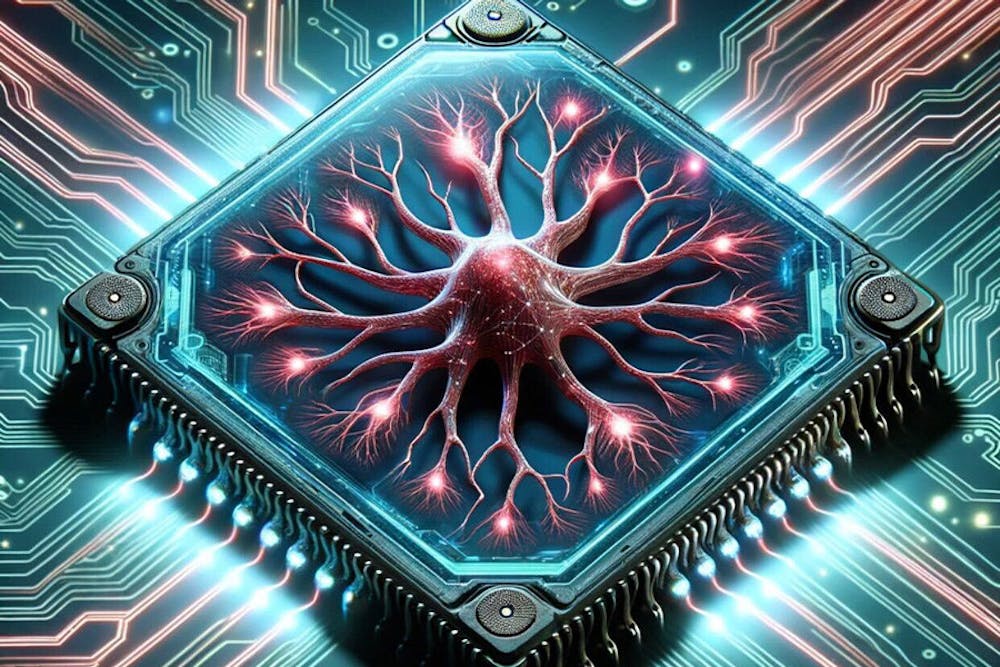A team of ASU students is pioneering the future of computing with their startup, Axoniverse. This student company is redefining the boundaries between biology and technology by developing a first-of-its-kind biochip, Axomini, slated for release in 2024.
Axoniverse, hosting its origins and development within the halls of ASU, is harnessing the power of biological processes to challenge the current landscape of artificial intelligence. Their biochip seeks to leverage the natural communication of neurons in order to process information.
"We use something called micro recruiters (which are) small arrays with a lot of electrodes on it where the neurons would lie," Vishnu Bhargav, graduate student and founder of Axoniverse, said. "They would grow in there, and they essentially communicate with each other through electrical signals."
The current focus of the Axoniverse team at ASU involves an innovative method of neuron training through interactive computer games.
"What I'm working on right now with the project is … taking the signals that Vishnu is managing through the hardware, and I am working with the simulator to allow the neurons to interact with the game," Adam Astor, a junior studying data science and a biocomputing engineer at Axoniverse, said.
This approach allows neurons to engage with a digital environment, interpreting and responding to stimuli without the human senses we rely on. By translating game mechanics into neural signals, they are pioneering a unique training regimen that could significantly enhance the computational abilities of these biological networks.
At Axoniverse, the research is not just future-oriented, but actively shaping the present of biocomputational technology. The team is focused on emulating desired behaviors within electronic frameworks, with potential applications in both gaming and medical fields.
"I'm currently working on … beyond these games, how specifically we can model certain desired behaviors," Iosef Perez, a sophomore studying psychology and neuroscience and a biocomputing engineer at Axoniverse, said.
This approach could pave the way for chips that mimic complex patterns, such as those observed in Alzheimer's disease, offering a promising direction for both technological and therapeutic developments, according to Perez.
Looking ahead, Axoniverse aims to outpace traditional AI with their innovative biochips, possible because their technology not only enhances efficiency, but also offers significant resource savings in the form of production and material costs.
"These neurons can lower down the resource cost to 10 (to) 40%," said Bhargav.
The resilience and versatility of their biochips are additional points of pride for the company.
"These biological networks are also very fault tolerant ... they won't easily pick up (signals) like the silicon chips," said Bhargav. "Most likely, they will adapt. Just take one biochip, and (it) will adapt to your requirements."
Given the use of neurons, innovations at Axoniverse involve genetic engineering to enhance the natural function of the tissue.
"We can edit the genes of the neurons so … that we can decrease the size of the neurons," said Bhargav. "One neuron can replace anywhere between 5,000 to 50,000 neuron (functions) depending upon what task that you're doing."
Despite the massive potential of the biochips, there are still some problems that the Axomini will face before widespread production.
"The only problem we see right now is scaling (the biochips) down," said Bhargav. "As of now, our first biochip would be around 10 centimeters."
Normally, computer chips are measured on the scale of millimeters, so this size is relatively big for the field.
"We're starting with a bigger size because that will be a better, more reliable bet to start with to have ... a proof of concept," Astor said.
Their goal is to first establish functionality and then concentrate on miniaturization. This phased strategy allows for a strong foundation upon which to build and refine.
"The further we'd be going (towards) the training stage ... they will become more adaptable, and then we can then actually scale down the process," said Perez.
This adaptability of neurons is central to the project, enabling the team to progressively refine their technology and potentially revolutionize how we interact with and utilize computational systems.
Furthermore, integration into existing technologies is crucial. Bhargav said the company is focused on how "to scale the humidity systems down in such a way that can be integrated into your phones and laptops."
Despite the technological complexities, the ASU students are committed to incorporating advanced systems into everyday tech.
"We'll have neurons probably in your phone or laptops, hopefully in ... two or three years," Bhargav said.
As Axoniverse forges ahead, it embodies the spirit of innovation that thrives at ASU. The student company not only represents the ideal of interdisciplinary research, but also the remarkable capabilities of student entrepreneurs to drive technological evolution.
With the anticipated launch of their Axomini, they are set to take a significant leap into the future of bio-inspired computing.
Edited by River Graziano, Sadie Buggle and Caera Learmonth.
Reach the reporter at dmanatou@asu.edu.
Like The State Press on Facebook and follow @statepress on X.
Dimitra is a junior studying biomedical engineering and physics. This is her second semester with The State Press. She has also worked as a research assistant in Kirian Lab.




